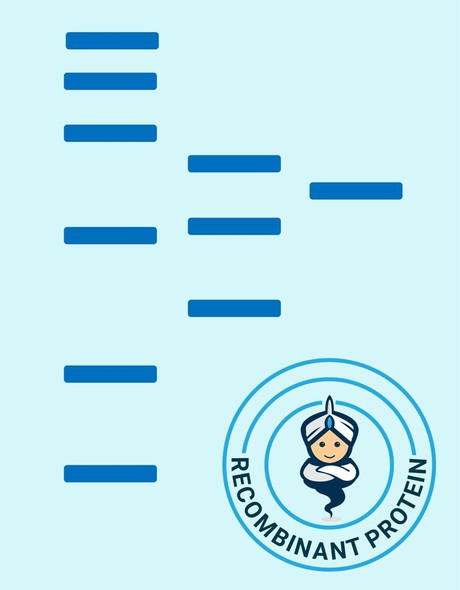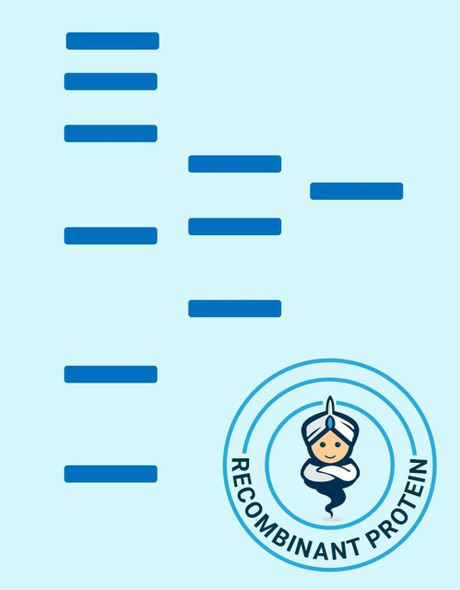Description
| Product Name: | Human CRYAB Recombinant Protein |
| Product Code: | RPPB5194 |
| Size: | 100µg |
| Species: | Human |
| Target: | CRYAB |
| Synonyms: | CRYA2, CTPP2, HSPB5, Crystallin Alpha B, CRYAB. |
| Source: | Escherichia Coli |
| Physical Appearance: | Sterile filtered colorless solution. |
| Formulation: | The CRYAB protein (1mg/ml) solution contains 20mM Tris-HCl buffer pH-7.5, 50mM NaCl and 1mM EDTA. |
| Stability: | Store at 4°C if entire vial will be used within 2-4 weeks. Store, frozen at -20°C for longer periods of time. For long term storage it is recommended to add a carrier protein (0.1% HSA or BSA).Avoid multiple freeze-thaw cycles. |
| Purity: | Greater than 95.0% as determined by SDS-PAGE. |
| Amino Acid Sequence: | MDIAIHHPWI RRPFFPFHSP SRLFDQFFGE HLLESDLFPT STSLSPFYLR PPSFLRAPSWFDTGLSEMRL EKDRFSVNLD VKHFSPEELK VKVLGDVIEV HGKHEERQDE HGFISREFHRKYRIPADVDP LTITSSLSSD GVLTVNGPRK QVSGPERTIP ITREEKPAVT AAPKK |
Alpha crystallins are composed of two gene products ; alpha-A and alpha-B, for acidic and basic, respectively. Alpha crystallins can be induced by heat shock and are members of the small heat shock protein (sHSP also known as the HSP20). They act as molecular chaperones and hold them in in large soluble aggregates. These heterogeneous aggregates consist of 30-40 subunits; the alpha-A and alpha-B subunits have a 3:1 ratio, respectively. Two additional function of a-crystallins are an autokinase activity and participation in the intracellular architecture. Alpha-B is expressed widely in many tissues and organs and occurs in many neurological diseases.
Recombinant CRYAB produced in E.Coli is a single,non-glycosylated polypeptide chain containing 175 amino acids and having a molecular mass of 20.1kDa. CRYAB is purified by proprietary chromatographic techniques.
| UniProt Protein Function: | CRYAB: a major structural protein of the eye lens. A member of the small heat shock protein (sHSP also known as the HSP20) family. Alpha-B is expressed in the lens as well as other tissues. Elevated expression of alpha-B crystallin occurs in many neurological diseases; a missense mutation cosegregated in a family with a desmin-related myopathy. |
| UniProt Protein Details: | Protein type:Heat shock protein; Chaperone Chromosomal Location of Human Ortholog: 11q22.3-q23.1 Cellular Component: actin filament bundle; cell surface; cytoplasm; cytosol; Golgi apparatus; microtubule cytoskeleton; mitochondrion; myelin sheath; nucleoplasm; nucleus; plasma membrane; Z disc Molecular Function:identical protein binding; metal ion binding; microtubule binding; protein binding; protein homodimerization activity; structural constituent of eye lens; unfolded protein binding Biological Process: aging; lens development in camera-type eye; microtubule polymerization or depolymerization; muscle contraction; muscle development; negative regulation of apoptosis; negative regulation of caspase activity; negative regulation of cell growth; negative regulation of intracellular transport; protein folding; protein homooligomerization; response to estradiol stimulus; response to hydrogen peroxide; response to hypoxia; stress-activated MAPK cascade; tubulin folding Disease: Cardiomyopathy, Dilated, 1ii; Cataract 16, Multiple Types; Myopathy, Myofibrillar, 2; Myopathy, Myofibrillar, Fatal Infantile Hypertonic, Alpha-b Crystallin-related |
| NCBI Summary: | Mammalian lens crystallins are divided into alpha, beta, and gamma families. Alpha crystallins are composed of two gene products: alpha-A and alpha-B, for acidic and basic, respectively. Alpha crystallins can be induced by heat shock and are members of the small heat shock protein (HSP20) family. They act as molecular chaperones although they do not renature proteins and release them in the fashion of a true chaperone; instead they hold them in large soluble aggregates. Post-translational modifications decrease the ability to chaperone. These heterogeneous aggregates consist of 30-40 subunits; the alpha-A and alpha-B subunits have a 3:1 ratio, respectively. Two additional functions of alpha crystallins are an autokinase activity and participation in the intracellular architecture. The encoded protein has been identified as a moonlighting protein based on its ability to perform mechanistically distinct functions. Alpha-A and alpha-B gene products are differentially expressed; alpha-A is preferentially restricted to the lens and alpha-B is expressed widely in many tissues and organs. Elevated expression of alpha-B crystallin occurs in many neurological diseases; a missense mutation cosegregated in a family with a desmin-related myopathy. Alternative splicing results in multiple transcript variants. [provided by RefSeq, Jan 2014] |
| UniProt Code: | P02511 |
| NCBI GenInfo Identifier: | 117385 |
| NCBI Gene ID: | 1410 |
| NCBI Accession: | P02511.2 |
| UniProt Secondary Accession: | P02511,O43416, Q9UC37, Q9UC38, Q9UC39, Q9UC40, Q9UC41 B0YIX0, |
| UniProt Related Accession: | P02511 |
| Molecular Weight: | 20,159 Da |
| NCBI Full Name: | Alpha-crystallin B chain |
| NCBI Synonym Full Names: | crystallin alpha B |
| NCBI Official Symbol: | CRYAB�� |
| NCBI Official Synonym Symbols: | MFM2; CRYA2; CTPP2; HSPB5; CMD1II; CTRCT16; HEL-S-101�� |
| NCBI Protein Information: | alpha-crystallin B chain |
| UniProt Protein Name: | Alpha-crystallin B chain |
| UniProt Synonym Protein Names: | Alpha(B)-crystallin; Heat shock protein beta-5; HspB5; Renal carcinoma antigen NY-REN-27; Rosenthal fiber component |
| Protein Family: | Alpha-crystallin |
| UniProt Gene Name: | CRYAB�� |
| UniProt Entry Name: | CRYAB_HUMAN |






